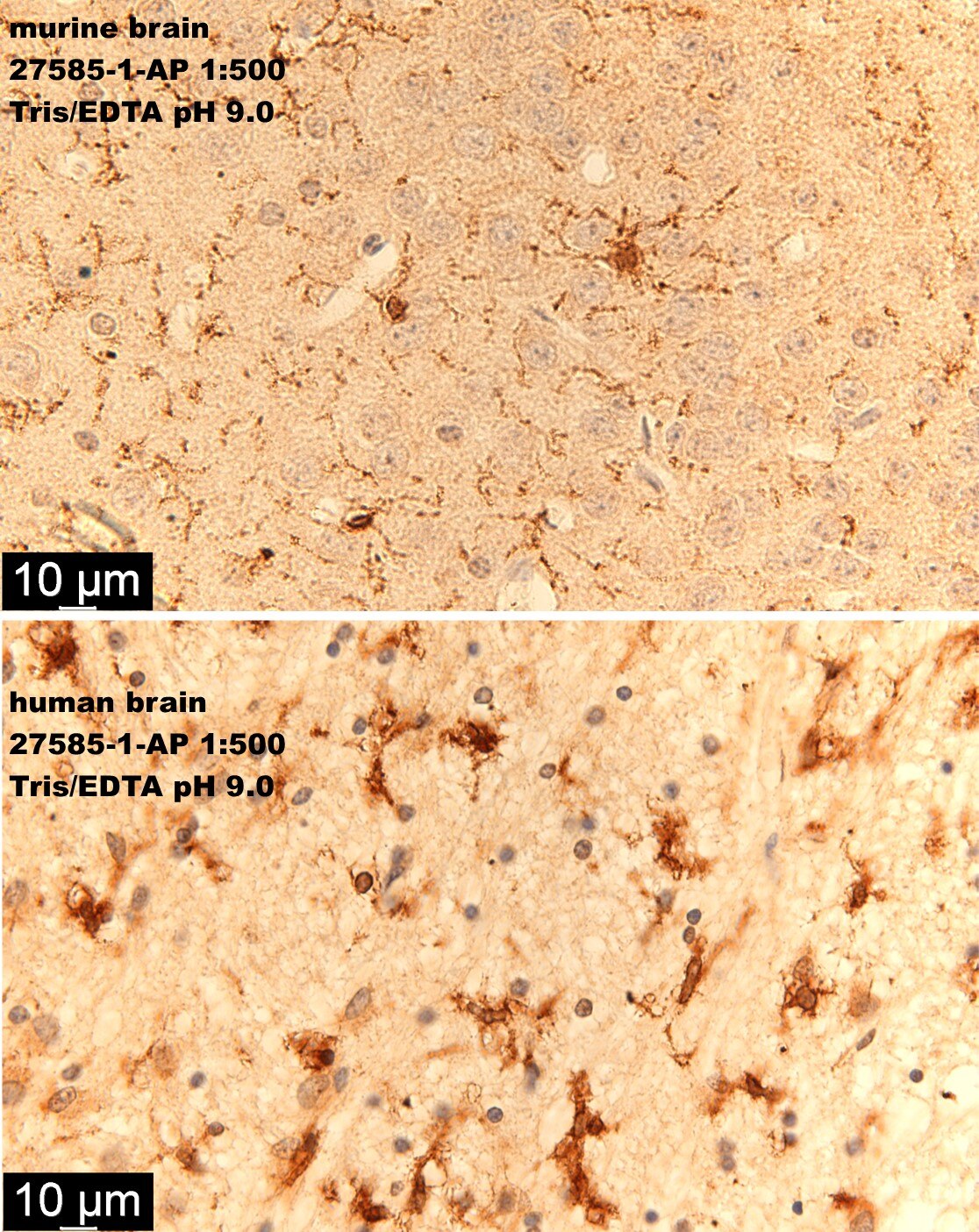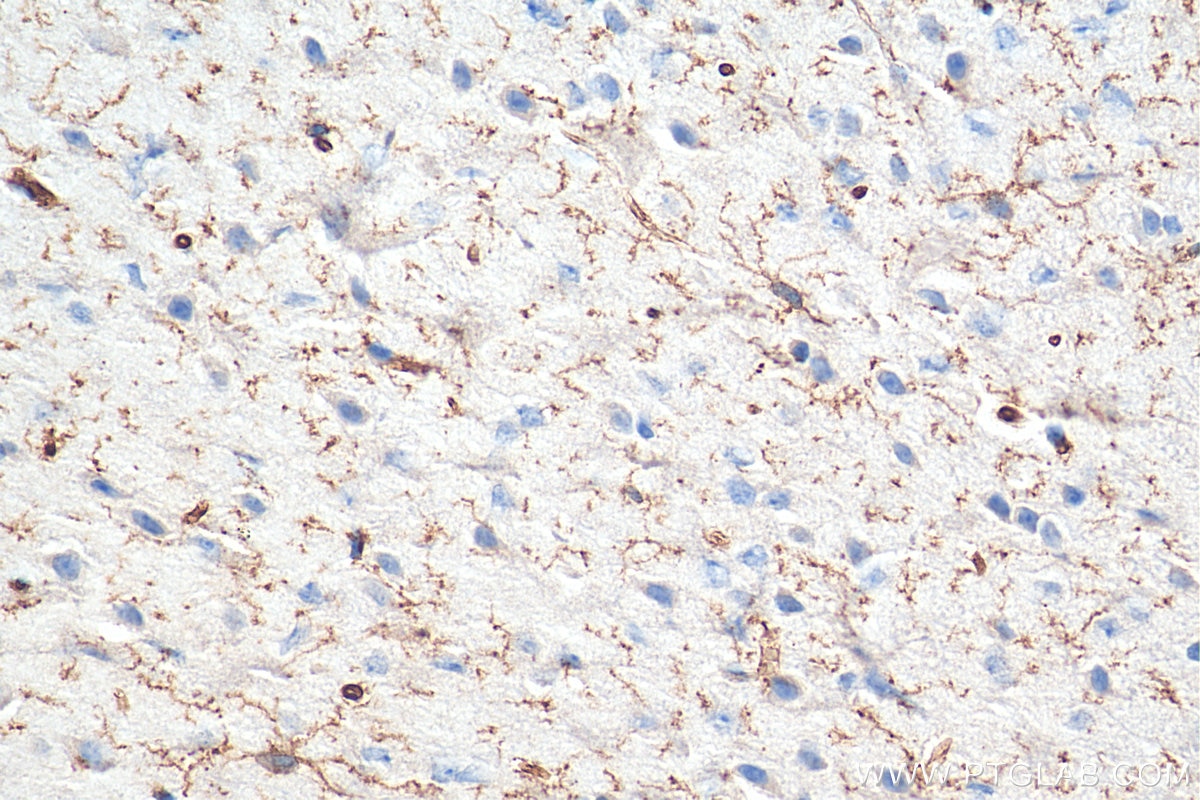Anticorps Polyclonal de lapin anti-TMEM119
TMEM119 Polyclonal Antibody for IHC, ELISA
Hôte / Isotype
Lapin / IgG
Réactivité testée
Humain, souris
Applications
WB, IHC, IF, FC, ELISA
Conjugaison
Non conjugué
N° de cat : 27585-1-AP
Synonymes
Galerie de données de validation
Applications testées
| Résultats positifs en IHC | tissu cérébral de souris, il est suggéré de démasquer l'antigène avec un tampon de TE buffer pH 9.0; (*) À défaut, 'le démasquage de l'antigène peut être 'effectué avec un tampon citrate pH 6,0. |
Dilution recommandée
| Application | Dilution |
|---|---|
| Immunohistochimie (IHC) | IHC : 1:400-1:1600 |
| It is recommended that this reagent should be titrated in each testing system to obtain optimal results. | |
| Sample-dependent, check data in validation data gallery | |
Applications publiées
| WB | See 2 publications below |
| IHC | See 2 publications below |
| IF | See 8 publications below |
| FC | See 1 publications below |
Informations sur le produit
27585-1-AP cible TMEM119 dans les applications de WB, IHC, IF, FC, ELISA et montre une réactivité avec des échantillons Humain, souris
| Réactivité | Humain, souris |
| Réactivité citée | Humain, souris |
| Hôte / Isotype | Lapin / IgG |
| Clonalité | Polyclonal |
| Type | Anticorps |
| Immunogène | TMEM119 Protéine recombinante Ag26269 |
| Nom complet | transmembrane protein 119 |
| Masse moléculaire calculée | 29 kDa |
| Poids moléculaire observé | 45 kDa |
| Numéro d’acquisition GenBank | NM_181724 |
| Symbole du gène | TMEM119 |
| Identification du gène (NCBI) | 338773 |
| Conjugaison | Non conjugué |
| Forme | Liquide |
| Méthode de purification | Purification par affinité contre l'antigène |
| Tampon de stockage | PBS avec azoture de sodium à 0,02 % et glycérol à 50 % pH 7,3 |
| Conditions de stockage | Stocker à -20°C. Stable pendant un an après l'expédition. L'aliquotage n'est pas nécessaire pour le stockage à -20oC Les 20ul contiennent 0,1% de BSA. |
Informations générales
TMEM119 immunohistochemistry might provide a useful tool for investigating the biology and pathology of human microglia(PMID: 26250788). Microglia can be detected clearly using Catalog#27585-1-AP.
Protocole
| Product Specific Protocols | |
|---|---|
| IHC protocol for TMEM119 antibody 27585-1-AP | Download protocol |
| Standard Protocols | |
|---|---|
| Click here to view our Standard Protocols |
Publications
| Species | Application | Title |
|---|---|---|
Sci Adv Single-cell analysis of human basal cell carcinoma reveals novel regulators of tumor growth and the tumor microenvironment. | ||
Nat Commun P-selectin axis plays a key role in microglia immunophenotype and glioblastoma progression. | ||
Glia Transmembrane protein 119 is neither a specific nor a reliable marker for microglia. | ||
Pharmacol Res MSCs-extracellular vesicles attenuated neuroinflammation, synapse damage and microglial phagocytosis after hypoxia-ischemia injury by preventing osteopontin expression. | ||
Front Immunol Didymin Suppresses Microglia Pyroptosis and Neuroinflammation Through the Asc/Caspase-1/GSDMD Pathway Following Experimental Intracerebral Hemorrhage. | ||
Neurochem Res BMP7 Attenuates Neuroinflammation after Spinal Cord Injury by Suppressing the Microglia Activation and Inducing Microglial Polarization Via the STAT3 Pathway |
Avis
The reviews below have been submitted by verified Proteintech customers who received an incentive forproviding their feedback.
FH Hannes (Verified Customer) (07-27-2020) | Immunohistochemistry (Formalin/PFA-fixed paraffin-embedded sections)IHC-P image of anti-TMEM119 (27585-1-AP) stained murine and human brain. The tissue was paraffin-embedded, formalin fixed. The tissue was then incubated with EnVision+ Single Reagents (HRP. Rabbit), undiluted for 1 hour at room temperature.
 |


